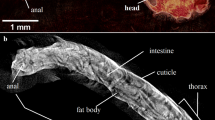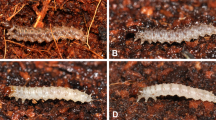Abstract
THE chironomid, Polypedilum vanderplanki Hint., breeds in small pools formed in shallow hollows on unshaded rocks in Horthern Nigeria and Uganda. The hollows are often only 5–9 in. deep, and during the rainy season they may fill and dry several times. When the pools dry up the larvæ also dry up and remain in this condition until it rains again, when, in about 1 hr. or so they resume feeding. The degree to which the larvæ dry up depends upon the relative humidity of the air. When moisture content was plotted against relative humidity, it was found that at 0 per cent relative humidity it was less than 3 per cent, at 60 per cent relative humidity it was 8 per cent, and at higher humidities the curve rose more steeply. In saturated air the moisture content altered from 3 to 33 per cent within 6 hr. at 25° C. The figures for moisture content are based on the assumption that the larva contains no water when its weight is constant at 106° C. The capacity to tolerate repeated dehydration is clearly of selective value to this species, and in the laboratory larvæ have survived as many as 10 dehydrations to a moisture content below 8 per cent. Between dehydrations they were allowed to feed in water, usually for 1–4 days.
This is a preview of subscription content, access via your institution
Access options
Subscribe to this journal
Receive 51 print issues and online access
$199.00 per year
only $3.90 per issue
Buy this article
- Purchase on Springer Link
- Instant access to full article PDF
Prices may be subject to local taxes which are calculated during checkout
Similar content being viewed by others
References
Hinton, H. E., Trans. Soc. Brit. Ent., 11, 209 (1953).
Hinton, H. E., Proc. Zool. Soc. Lond., 121, 371 (1951).
Buxton, P. A., J. Ecol., 12, 127 (1924).
Author information
Authors and Affiliations
Rights and permissions
About this article
Cite this article
HINTON, H. A Fly Larva that tolerates Dehydration and Temperatures of −270° to +102° C.. Nature 188, 336–337 (1960). https://doi.org/10.1038/188336a0
Issue Date:
DOI: https://doi.org/10.1038/188336a0
This article is cited by
-
Ionizing radiation responses appear incidental to desiccation responses in the bdelloid rotifer Adineta vaga
BMC Biology (2024)
-
Rehydration of the sleeping chironomid, Polypedilum vanderplanki Hinton, 1951 larvae from cryptobiotic state up to full physiological hydration (Diptera: Chironomidae)
Scientific Reports (2022)
-
Mechanisms and evolution of resistance to environmental extremes in animals
EvoDevo (2019)
-
Deeper knowledge of shallow waters: reviewing the invertebrate fauna of southern African temporary wetlands
Hydrobiologia (2019)
-
The springtail Megaphorura arctica survives extremely high osmolality of body fluids during drought
Journal of Comparative Physiology B (2018)
Comments
By submitting a comment you agree to abide by our Terms and Community Guidelines. If you find something abusive or that does not comply with our terms or guidelines please flag it as inappropriate.



